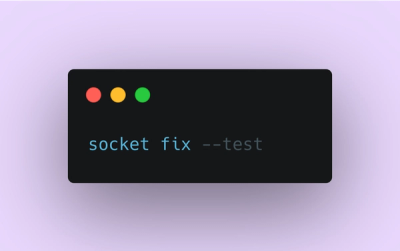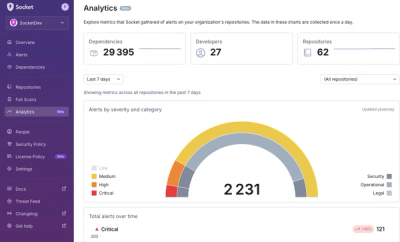
Product
Introducing Socket Fix for Safe, Automated Dependency Upgrades
Automatically fix and test dependency updates with socket fix—a new CLI tool that turns CVE alerts into safe, automated upgrades.
scala-relay-compiler
Advanced tools
A compiler tool for building GraphQL-driven Scala.js applications.
The purpose of this project is to generate Scala.js bindings for the
relay-compiler. Typically the relay-compiler generates flow bindings
along with the compiled queries. This project replaces that generation and
outputs js.native traits instead. It is experimental and the code needs work,
but it can generated traits for deep hierarchical graphs.
It uses flow because it's what relay uses, and its better than raw javascript.
It uses outputDir to generate all the source files and whatnot in the same package.
So its a big flat package repository in the same directory.
Typically (resourceManaged in Compile).value / "relay-compiler-out" is where it outputs
in sbt parlance.
0.11.0 - Relay 1.6.20.9.0 - Relay 1.5.00.8.2 - Relay 1.4.0$ ./bin/scala-relay-compiler.js --src example/src/ --schema example/schema.graphql --out example/out/
js.| to
join disjoint fields, even though in fact they are not disjoint,
they are a union, however, this requires a fix later down the line.@scalajs(extends: String) This can give you a parent class to mixin. It's
your job to verify it.@scalajs(useNulls: Boolean) this can give you finer control on using A | Null
on a Fragment, field or inline fragment.Ill walk you through a simple example. I'll assume you know roughly how Relay Modern works.
We'll obviously need a schema, for which we'll use the example provided.
schema {
query: Root
}
type Root {
dictionary: [Word]
}
type Word {
id: String!
definition: WordDefinition
}
type WordDefinition {
id: String
text: String
image: String
}
From this we'll want to generate some queries in which Ill list one top level query including
two fragments. Now this is where we start to diverge from the stock relay-compiler. Our method
of collecting queries/fragments/mutations is a regex (I know, ugly) through *.scala files. We look for the @gql(""" indicator and its corresponding """) to isolate the queries.
Here is an example taken straight from the repository.
object Foo {
val otherGql = @gql("""
fragment DictionaryComponent_definition on WordDefinition {
text
image
}
""")
val gql = @gql("""
fragment DictionaryComponent_word on Word {
id
definition {
...DictionaryComponent_definition
text
id
}
}
""")
val query = @gql("""
query DictionaryQuery {
dictionary {
...DictionaryComponent_word
}
}
""")
}
So now we have the schema, and a query + two fragments. Time to generate! So we run the following command.
$ ./bin/scala-relay-compiler.js --src example/src/ --schema example/schema.graphql --out example/out/
And get three files. Queries and Mutations or top level components all have the same structure. The object represents the top level query, and the trait represents the data coming over the wire.
This basically replaces the js files that typically get generated by the compiler. Specifically the
part the runtime needs is in DictionaryQuery.query
So the generation below handles DictionaryQuery. I cut some text for brevity
trait DictionaryQuery extends js.Object {
/** Combined the fields on a spread: DictionaryComponent_word */
val dictionary : js.Array[DictionaryComponent_word]
}
object DictionaryQuery extends _root_.relay.graphql.GenericGraphQLTaggedNode {
val query: _root_.relay.graphql.ConcreteBatch = _root_.scala.scalajs.js.JSON.parse("""{
"fragment": {
....
"text": "query DictionaryQuery {\n dictionary {\n ...DictionaryComponent_word\n }\n}\n\nfragment DictionaryComponent_word on Word {\n id\n definition {\n ...DictionaryComponent_definition\n text\n id\n }\n}\n\nfragment DictionaryComponent_definition on WordDefinition {\n text\n image\n}\n"
}""").asInstanceOf[_root_.relay.graphql.ConcreteBatch]
What does fragments look like you ask? You'll notice some comments, its basically a way to look up what happened in the code to make sure the generator didn't do something wonky.
As you can see the top level definition lives at the root package relay.generated And all the sub
traits get generated underneath the trait's companion object.
package relay.generated
trait DictionaryComponent_word extends js.Object {
/** New fields added, conflicts detected. */
val definition : DictionaryComponent_word.Definition
val id : String
}
object DictionaryComponent_word extends _root_.relay.graphql.GenericGraphQLTaggedNode {
trait Definition extends js.Object {
val id : String
/** getDirectMembersForFrag child of DictionaryComponent_definition Combining fields, with or? "true" */
val text : String
/** getDirectMembersForFrag child of DictionaryComponent_definition */
val image : String
}
val query: _root_.relay.graphql.ConcreteFragment = _root_.scala.scalajs.js.JSON.parse("""{
....
""")
}
Ill skip the other definition because there's nothing additionally interesting.
So that's it.
You can use from sbt by using, and it will include the tiny shim of javascript traits to use.
addSbtPlugin("com.dispalt.relay" % "sbt-relay-compiler" % "<version>")
A list of tasks/ideas the community could help with. High | Med | Low refers to the complexity/difficulty.
InlineFragments so they work properly. Right now we just really
don't handle them.FAQs
A compiler tool for building GraphQL-driven Scala.js applications.
The npm package scala-relay-compiler receives a total of 33 weekly downloads. As such, scala-relay-compiler popularity was classified as not popular.
We found that scala-relay-compiler demonstrated a not healthy version release cadence and project activity because the last version was released a year ago. It has 1 open source maintainer collaborating on the project.
Did you know?

Socket for GitHub automatically highlights issues in each pull request and monitors the health of all your open source dependencies. Discover the contents of your packages and block harmful activity before you install or update your dependencies.

Product
Automatically fix and test dependency updates with socket fix—a new CLI tool that turns CVE alerts into safe, automated upgrades.

Security News
CISA denies CVE funding issues amid backlash over a new CVE foundation formed by board members, raising concerns about transparency and program governance.

Product
We’re excited to announce a powerful new capability in Socket: historical data and enhanced analytics.